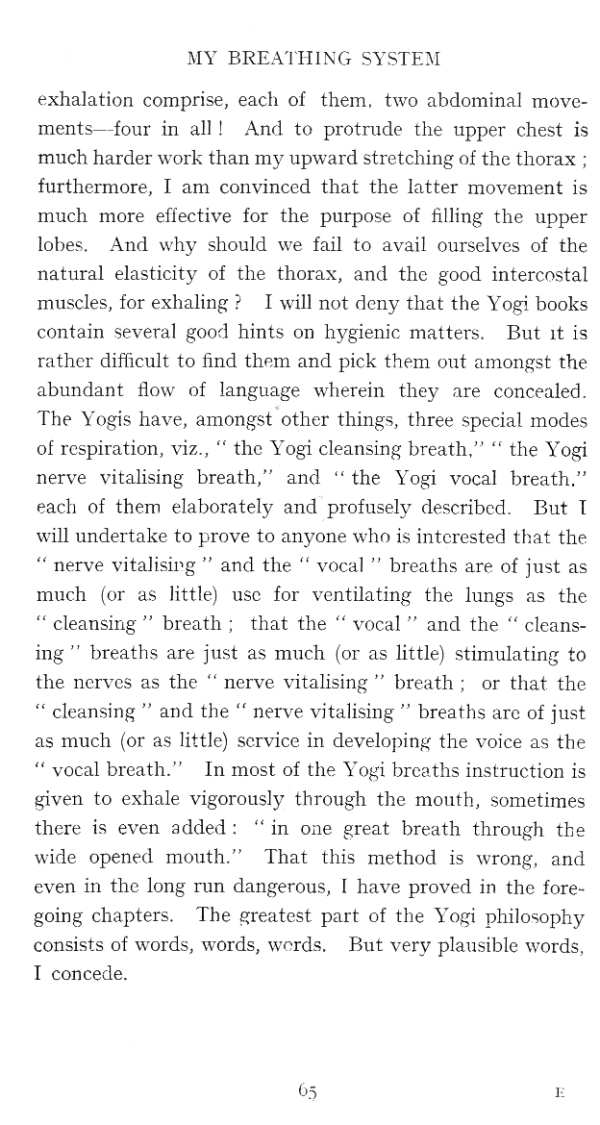mbs 065

MY BREATH ING SYSTEM
exhalation comprise, each of them. two abdominal move-ments—four in all ! And to protnide the npper chest is much harder work than my upward stretching of thc thorax ; furthermore, I am convinced that the latter movement is much morę effective for the purpose of filling the upper lobes. And why should we fail to avail ourselves of the natural elasticity of the thorax, and the good intercostal muscles, for exhaling ? I will not deny that the Yogi books contain several good hints on hygienic matters. But lt is rathcr difficult to find them and pick them out amongst the abundant flow of language wherein they are concealed. The Yogis have, amongst other things, tliree special modes of rcspiration, viz., “ thc Yogi cleansing breath,” “ the Yogi nerve vitalising breath,” and “ the Yogi vocal breath.” each of them elaborately and profusely describcd. But I will undertake to prove to anyone who is intcrested that the " nerve vitalisii*g ” and the " vocal ” breaths are of just as much (or as little) usc for ventilating the lungs as the “ cleansing ” breath ; that the “ vocal ” and the " cleansing ” breaths are just as much (or as little) stimulating to the nervcs as the “ nerve vitalising ” breath ; or that the “ cleansing ” and the " nerve vita1ising ” breaths are of just as much (or as little) scrvice in developing the voice as the " vocal breath.” In most of the Yogi breaths instruction is given to exhale vigorously through the mouth, sometimes there is even added : “ in one great breath through the wide opened mouth.” That this method is wrong, and cven in thc long run dangerous, I have proved in the fore-going chapters. The greatest part of the Yogi philosophy consists of words, words, words. But very plausible words. I concede.
i
t>5
Wyszukiwarka
Podobne podstrony:
system 46 4B Heart, weak, tat, distended, displaced. nervous. Study " My Breath-ing System ” an
mbs 005 MY BREATHING SYSTEM BYLIEUT. J. P. MI LLER, K.D. Author of My System," " My System
mbs 011 MY BREATHING SYSTEM and violent palpitatiops. Sncli an overstrained licart could never last
mbs 014 MY BREATHING SYSTEM slow, regular respiration, even during the hardcst and most protracted e
mbs 022 MY BREATHING SYSTEM against the invasion and throw ol f thc gernis, which arc ejected with t
mbs 027 MY BREATHING SYSTEM sucked in. For persons who lind it very difficult to acquire tłiis contr
mbs 035 MY BREATHING SYSTEM How to Expand and Contract the Thorax to its fullest Extent The thoracic
mbs 038 MY BREATHING SYSTEM scientiiically established this fact. He said, in a recent lecture : &qu
mbs 040 MY BREATHING SYSTEM expansiou alone gives tlić best result, others, Jikt* the French lieuteu
mbs 042 MY BREATHING SYSTEM the liarm done by such old habits that special excrcise of “ abdominal&q
mbs 047 MY BREATHING SYSTEM are so strong that they are able to break a chain, put around the chest,
mbs 053 MY BREATHING SYSTEM navel, or at all events not higher than on a level with the openings of
mbs 055 MY BREATHING SYSTEM Whcn the diaphragm is not paralysed it readily follows thc movcment of t
więcej podobnych podstron